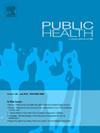路易斯安那州因种族、农村、贫困和医疗服务可得性而导致的严重孕产妇发病率
IF 3.9
3区 医学
Q1 PUBLIC, ENVIRONMENTAL & OCCUPATIONAL HEALTH
引用次数: 0
摘要
目的:在美国,种族和基于地方的变量,如农村、邮政编码水平的贫困和县产科护理沙漠状况,与严重的孕产妇发病率和孕产妇死亡率有关。我们在路易斯安那州研究了这些关联,路易斯安那州是美国孕产妇死亡率最高的州之一。研究设计这是一项出生队列研究。方法我们使用路易斯安那州2016年至2021年的住院分娩住院出院数据。使用邮政编码内嵌套个体的混合效应logistic回归模型,根据种族和基于地方的变量(总体和按种族分层)估计非输血严重孕产妇发病率(nt-SMM,使用CDC指数定义)的调整优势比(aOR)。结果326,597例分娩住院患者中,有2486例(0.77%)涉及非smm。在调整社会人口因素、合并症指数和位置变量后,非西班牙裔黑人和西班牙裔个体与非西班牙裔白人相比,nt-SMM的风险增加(aor分别为1.36,95% CI 1.23-1.51和1.39,95% CI 1.21-1.59)。居住在产科护理沙漠县或农村邮政编码没有增加风险;然而,居住在贫困最高四分位数的邮政编码地区与风险增加相关(aOR 1.26, 95% CI 1.04-1.51)。当按种族和民族进行分层时,居住在最贫困邮政编码的非西班牙裔黑人和西班牙裔个体的风险仍然增加(aOR分别为1.33,95% CI 1.00 - 1.78和1.32,95% CI 1.05-1.65),而居住在产科护理沙漠中的黑人个体的风险可能增加(aOR为1.33,95% CI 1.00 - 1.76),但置信区间包括1.00。结论在路易斯安那州,要降低非smm发生率,必须解决社会因素,特别是生活在最高贫困水平地区和产妇护理沙漠地区的非西班牙裔黑人,因为他们在这一人群中风险最高。本文章由计算机程序翻译,如有差异,请以英文原文为准。
Severe maternal morbidity in Louisiana by race, rurality, poverty, and availability of care
Objectives
Race-ethnicity and place-based variables such as rurality, ZIP code-level poverty, and county maternity care desert status have been associated with severe maternal morbidity and maternal mortality rates in the US. We examined these associations in Louisiana, which has one of the highest maternal mortality rates in the US.
Study design
This was a birth cohort study.
Methods
We used state-wide inpatient birth hospitalization discharge data in Louisiana between 2016 and 2021. Mixed-effects logistic regression models with individuals nested within ZIP codes were used to estimate adjusted odds ratios (aOR) for non-transfusion severe maternal morbidity (nt-SMM, defined using the CDC index) according to race-ethnicity and place-based variables (overall and stratified by race-ethnicity).
Results
Among 326,597 birth hospitalizations, 2486 (0.77 %) involved nt-SMM. Non-Hispanic Black and Hispanic individuals had increased risk of nt-SMM compared to Non-Hispanic White individuals, after adjustment for sociodemographic factors, a comorbidity index, and place-placed variables (aORs 1.36, 95 %CI 1.23–1.51 and 1.39, 95 %CI 1.21–1.59, respectively). Residence in a maternity care desert county or rural ZIP code did not increase risk; however, residence in a ZIP code in the highest quartile of poverty was associated with increased risk (aOR 1.26, 95 %CI 1.04–1.51). When stratified by race and ethnicity, an increased risk remained for Non-Hispanic Black and Hispanic individuals residing in the highest-poverty ZIP codes (aORs 1.33, 95 % CI 1.00–1.78 and 1.32, 95 % CI 1.05–1.65, respectively), and a potential increased risk associated with living in a maternity care desert emerged for Black individuals (aOR 1.33, 95 % CI 1.00–1.76), but confidence intervals included 1.00.
Conclusions
In Louisiana, to reduce the rate of nt-SMM, social factors must be addressed, especially for non-Hispanic Black individuals living in areas with the highest levels of poverty and in maternity care deserts, as they had the highest risks in this population.
求助全文
通过发布文献求助,成功后即可免费获取论文全文。
去求助
来源期刊

Public Health
医学-公共卫生、环境卫生与职业卫生
CiteScore
7.60
自引率
0.00%
发文量
280
审稿时长
37 days
期刊介绍:
Public Health is an international, multidisciplinary peer-reviewed journal. It publishes original papers, reviews and short reports on all aspects of the science, philosophy, and practice of public health.
 求助内容:
求助内容: 应助结果提醒方式:
应助结果提醒方式:


